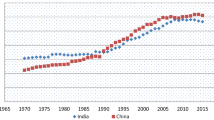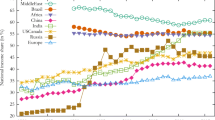Abstract
This paper examines the relationship between foreign direct investment (FDI) and income distribution in the host country as measured by the Gini coefficient. After providing some background and reviewing the extant literature, it undertakes a panel unit root and cointegration analysis that tests whether FDI has a non-linear impact on income inequality in seven selected Southeast Asian countries over the period 1990 to 2013. The paper finds strong evidence for panel cointegration using the Pedroni Augmented Dickey Fuller (ADF) and Phillips-Perron (PP) tests. Thus, it proceeds to utilize the group-mean fully modified ordinary least squares (FMOLS) procedure to generate long-run estimates that are unbiased and consistent. The FMOLS estimator is also extremely accurate even in panels with very heterogeneous serial correlation dynamics, fixed effects, and endogenous regressors. The results confirm the hypothesis that FDI inflows tend to raise income inequality in the short run but reduce it in the long run. In this study, the Gini index starts decreasing after FDI inflows as a percentage of GDP reaches 5.6. The fact that the Gini coefficient reaches its maximum at a relatively low level of FDI inflows suggests that sample countries are endowed with substantial absorptive capacity. In other words, they will shift into the new technological paradigm quickly, thus supporting pro-globalization claims that, on balance, FDI is more beneficial than harmful.
Similar content being viewed by others
Notes
Four countries in the region, namely Singapore, Myanmar, Brunei, and East Timor, were excluded in this analysis due to the lack of data.
A Hausman test was implemented to determine whether the FEM or random effects model (REM) should be used. The null hypothesis is that the REM is appropriate, the alternative is that the FEM is appropriate. Since the Hausman statistics were highly significant in both cases, we rejected the null and concluded that the FEM was appropriate. The test results are available upon request.
This study relaxed the assumption that the disturbances across countries are unrelated, and estimated the model via the Seemingly Unrelated Regression (SUR) procedure. The rationale resides in the plausible hypothesis that events such as the 1997–98 Asian Crisis and the business cycle originating in the OECD countries are likely to affect all southeast Asian economies to varying degrees. The estimated coefficients for the SUR model (available upon request) are consistent with the FEM estimates and, in the case of the FDI inflows and FDI stock variables, of greater statistical significance than those reported in Table 1; viz., t-ratios of 3.45 and 1.94, respectively, for the flow and stock variables.
For the computation of the test statistics, please refer to Pedroni (1999).
Franco and Gerussi (2013), whose model served as the basis for the conceptual framework in this thesis, utilize the one step SYS-GMM estimator to account for endogeneity. The GMM estimators, however, are usually employed when one has no knowledge of the underlying distribution. In a long panel, like the one utilized in this thesis, it is assumed that the errors are normally distributed, and the use of the FMOLS estimator is warranted. In fact, Pedroni (2002) has shown, via small sample Monte Carlo simulations, that the bias (and sampling variance) of the group mean FMOLS estimator (based on the “between” dimension of the panel) is very small, even in extreme cases when both the N and T dimensions are as small as N = 10 and T = 10 (and they become insignificant as the time dimension increases).
The value was calculated by setting the first derivative equal to zero. The 95% confidence interval for the turning point lies between 5.1 and 6.1. Since some coefficients for trade and GDP per capita were not significant, turning points for these variables were not calculated.
The mean FDIINFLOWS was 3.5% of GDP for this sample, with several countries exhibiting significantly higher ratios, e.g., Vietnam (a maximum of 11.9) and Malaysia (a maximum of 8.76). While FDI inflows tend to fluctuate, there seems to be an increasing trend in the 2000s. In 2013, the mean was 4.1% for the sample. The mean for the region was higher at 4.7% of GDP over the period 1990 to 2013. Again, it was even higher in recent years, at 5.8% in 2013 and 5.9% in 2015.
References
Afonso, A.,et al. (2008). Income Distribution Determinants and Public Spending Efficiency. European Central Bank Working Paper Series, No. 861.
Aghion, P., & Howitt, P. (1999). On the macroeconomic effects of major technological change. Nordic Journal of Political Economy, 25, 15–32.
Arbache, J. S., et al. (2004). Trade liberalisation and wages in developing countries. The Economic Journal, 114(493), F73–F96.
Beyer, H., Rojas, P., & Vergara, R. (1999). Trade liberalization and wage inequality. Journal of Development Economics, 59(1), 103–123.
Bhandari, B. (2007). Effect of inward foreign direct investment on income inequality in transition countries. Journal of Economic Integration, 22(4), 888–928.
Calderón, C., & Servén, L. (2004). The Effects of Infrastructure Development on Growth and Income Distribution. Central Bank of Chile Working Papers, No. 270.
Chang, H. J. (2003). Globalization, Economic Development and the Role of the State. Zed.
Choi, C. (2006). Does foreign direct investment affect domestic income inequality? Applied Economics Letters, 13(12), 811–814.
Coxhead, I. (2014). Routledge Handbook of Southeast Asian Economics. Routledge.
Cypher, J. W. & Dietz, J. L. (2004). The Process of Economic Development. Routledge.
Farhan, M. Z. M., et al. (2014). FDI and income inequality in ASEAN-5 countries: a Quantile regression approach. ProsidinPer KEM, 9, 601–608.
Feenstra, R. C., & Hanson, G. H. (1995). Foreign Direct Investment and Relative Wages: Evidence from Mexico’s Maquiladoras. NBER Working Paper, No. 5122.
Figini, P., & Görg, H. (2011). Does foreign direct investment affect wage inequality? An empirical investigation. The World Economy, 34(9), 1455–1475.
Franco, C., & Gerussi, E. (2013). Trade, foreign direct investments (FDI) and income inequality: empirical evidence from transition countries. The Journal of International Trade and Economic Development, 22(8), 1131–1160.
Helpman, E., & Trajtenberg, M. (1994). A Time to Sow and a Time to Reap: Growth Based on General Purpose Technologies. NBER Working Paper, No. 4854.
Im, K. S., et al. (2003). Testing for unit roots in heterogeneous panels. Journal of Econometrics, 115(1), 53–74.
Levin, A., et al. (2002). Unit root tests in panel data: asymptotic and finite-sample properties. Journal of Econometrics, 108(1), 1–24.
Lindert, P. H., & Williamson, J. G. (2001). Does Globalization Make the World More Unequal? NBER Working Paper, No. 8228.
Mah, J. S. (2011). Export promotion policies, export composition and economic development of Korea. The Law and Development Review, 4(2), 2.
Mukaramah, H., Siti, H. C. M., & Zalina, Z. (2014). Do FDI Deteriorate Income Distribution? Evidence from Malaysia. AABSS Conference and Journals.
Obstfeld, M. (1998). The Global Capital Market: Benefactor or Menace? NBER Working Paper, No. 6559.
Pedroni, P. (1999). Critical values for cointegration tests in heterogeneous panels with multiple regressors. Oxford Bulletin of Economics and Statistics, 61(S1), 653–670.
Pedroni, P. (2000). Fully Modified OLS for Heterogeneous Cointegrated Panels. In: Advanced Econometrics, Vol. 15. Nonstationary Panels, Cointegration in Panels and Dynamic Panels: A Survey. Ed. by Baltagi, B.H. and C. Kao.
Pissarides, C. A. (1997). Learning by trading and the returns to human Capital in Developing Countries. World Bank Economic Review, 11(1), 17–32.
Ramirez, M. (2007). A panel unit root and panel cointegration test of the complementarity hypothesis in the Mexican case, 1960-2001. Atlantic Economic Journal, 35(3), 343–356.
Reuveny, R., & Li, Q. (2003). Economic openness, democracy, and income inequality an empirical analysis. Comparative Political Studies, 36(5), 575–601.
Sjöholm, F. (2014). Foreign Direct Investments in Southeast Asia. Social Science Research Network Scholarly Paper, No. 2475944.
The World Bank (2015). World Bank Database.
UNCTAD (2004). Foreign Direct Investment and Performance Requirements: New Evidence from Selected Countries. United Nations Publications.
UNCTAD (2014). World Investment Report 2014 - Investing in the SDGs: An Action Plan. United Nations Publications.
Wade, R. (1990). Governing the Market: Economic Theory and the Role of Government in East Asian Industrialization. Princeton University Press.
Wood, A. (1997). Openness and wage inequality in developing countries: the Latin American challenge to east Asian conventional wisdom. World Bank Economic Review, 11(1), 33–57.
Author information
Authors and Affiliations
Corresponding author
Rights and permissions
About this article
Cite this article
Cho, H.C., Ramirez, M.D. Foreign Direct Investment and Income Inequality in Southeast Asia: a Panel Unit Root and Panel Cointegration Analysis, 1990–2013. Atl Econ J 44, 411–424 (2016). https://doi.org/10.1007/s11293-016-9521-7
Published:
Issue Date:
DOI: https://doi.org/10.1007/s11293-016-9521-7
Keywords
- Gini coefficient
- Foreign direct investment (FDI)
- Fully modified ordinary least squares (FMOLS)
- Panel unit roots
- Panel cointegration test
- Southeast Asian countries




